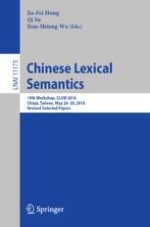2018 | OriginalPaper | Chapter
Placement Verbs in Chinese and English: Language-Specific Lexicalization Patterns
Authors : Meichun Liu, Jui-Ching Chang
Published in: Chinese Lexical Semantics
Publisher: Springer International Publishing
Activate our intelligent search to find suitable subject content or patents.
Select sections of text to find matching patents with Artificial Intelligence. powered by
Select sections of text to find additional relevant content using AI-assisted search. powered by

 ‘stand’ is originally a verb of human posture and can also be used to denote placement as in
‘stand’ is originally a verb of human posture and can also be used to denote placement as in
 stood the book on the table.’ But as an archaic form, it is less prototypical as a posture verb since it cannot be used to denote ‘assuming posture’ (*
stood the book on the table.’ But as an archaic form, it is less prototypical as a posture verb since it cannot be used to denote ‘assuming posture’ (*
 He stood up.’).
He stood up.’).